2014 KIA Sedona air condition
[x] Cancel search: air conditionPage 96 of 382
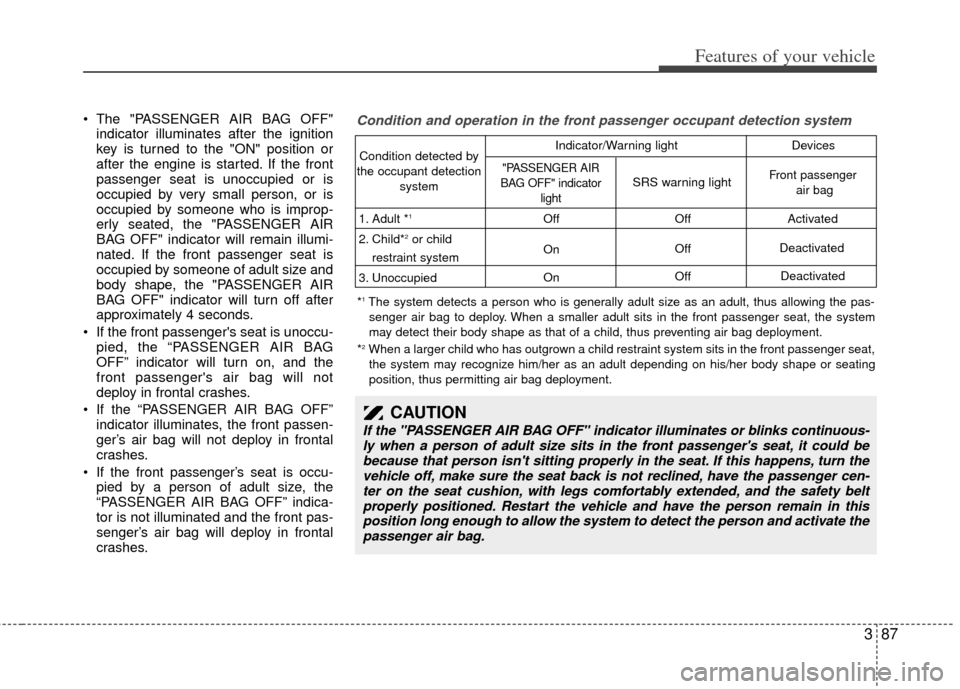
387
Features of your vehicle
The "PASSENGER AIR BAG OFF"indicator illuminates after the ignition
key is turned to the "ON" position or
after the engine is started. If the front
passenger seat is unoccupied or is
occupied by very small person, or is
occupied by someone who is improp-
erly seated, the "PASSENGER AIR
BAG OFF" indicator will remain illumi-
nated. If the front passenger seat is
occupied by someone of adult size and
body shape, the "PASSENGER AIR
BAG OFF" indicator will turn off after
approximately 4 seconds.
If the front passenger's seat is unoccu- pied, the “PASSENGER AIR BAG
OFF” indicator will turn on, and the
front passenger's air bag will not
deploy in frontal crashes.
If the “PASSENGER AIR BAG OFF” indicator illuminates, the front passen-
ger’s air bag will not deploy in frontal
crashes.
If the front passenger’s seat is occu- pied by a person of adult size, the
“PASSENGER AIR BAG OFF” indica-
tor is not illuminated and the front pas-
senger’s air bag will deploy in frontal
crashes.Condition and operation in the front passenger occupant detection system
Condition detected by
the occupant detection system
1. Adult *
1
2. Child*2or child
restraint system
3. Unoccupied Off
On
On
Off
Off
Off
Activated
Deactivated
"PASSENGER AIR
BAG OFF" indicator lightSRS warning lightFront passengerair bag
Deactivated
Indicator/Warning light Devices
*1The system detects a person who is generally adult size as an adult, thus allowing the pas-
senger air bag to deploy. When a smaller adult sits in the front passenger seat, the system
may detect their body shape as that of a child, thus preventing air bag deployment.
*
2When a larger child who has outgrown a child restraint system sits in the front passenger seat, the system may recognize him/her as an adult depending on his/her body shape or seating
position, thus permitting air bag deployment.
CAUTION
If the "PASSENGER AIR BAG OFF" indicator illuminates or blinks continuous- ly when a person of adult size sits in the front passenger's seat, it could bebecause that person isn't sitting properly in the seat. If this happens, turn thevehicle off, make sure the seat back is not reclined, have the passenger cen- ter on the seat cushion, with legs comfortably extended, and the safety beltproperly positioned. Restart the vehicle and have the person remain in this position long enough to allow the system to detect the person and activate thepassenger air bag.
Page 99 of 382
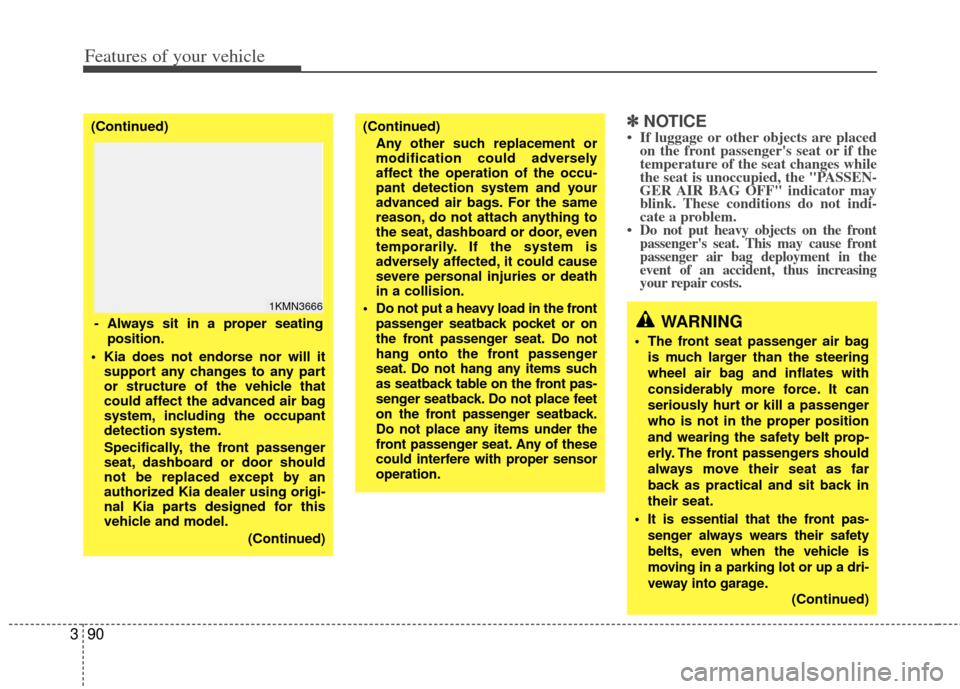
Features of your vehicle
90
3
✽
✽
NOTICE
• If luggage or other objects are placed
on the front passenger's seat or if the
temperature of the seat changes while
the seat is unoccupied, the "PASSEN-
GER AIR BAG OFF" indicator may
blink. These conditions do not indi-
cate a problem.
•
Do not put heavy objects on the front
passenger's seat. This may cause front
passenger air bag deployment in the
event of an accident, thus increasing
your repair costs.
WARNING
The front seat passenger air bag
is much larger than the steering
wheel air bag and inflates with
considerably more force. It can
seriously hurt or kill a passenger
who is not in the proper position
and wearing the safety belt prop-
erly. The front passengers should
always move their seat as far
back as practical and sit back in
their seat.
It is essential that the front pas-
senger always wears their safety
belts, even when the vehicle is
moving in a parking lot or up a dri-
veway into garage.
(Continued)
(Continued) Any other such replacement or
modification could adversely
affect the operation of the occu-
pant detection system and your
advanced air bags. For the same
reason, do not attach anything to
the seat, dashboard or door, even
temporarily. If the system is
adversely affected, it could cause
severe personal injuries or death
in a collision.
Do not put a heavy load in the front
passenger seatback pocket or on
the front passenger seat. Do not
hang onto the front passenger
seat. Do not hang any items such
as seatback table on the front pas-
senger seatback. Do not place feet
on the front passenger seatback.
Do not place any items under the
front passenger seat. Any of these
could interfere with proper sensor
operation.
(Continued)
Kia does not endorse nor will it support any changes to any part
or structure of the vehicle that
could affect the advanced air bag
system, including the occupant
detection system.
Specifically, the front passenger
seat, dashboard or door should
not be replaced except by an
authorized Kia dealer using origi-
nal Kia parts designed for this
vehicle and model.
(Continued)
1KMN3666
- Always sit in a proper seatingposition.
Page 101 of 382
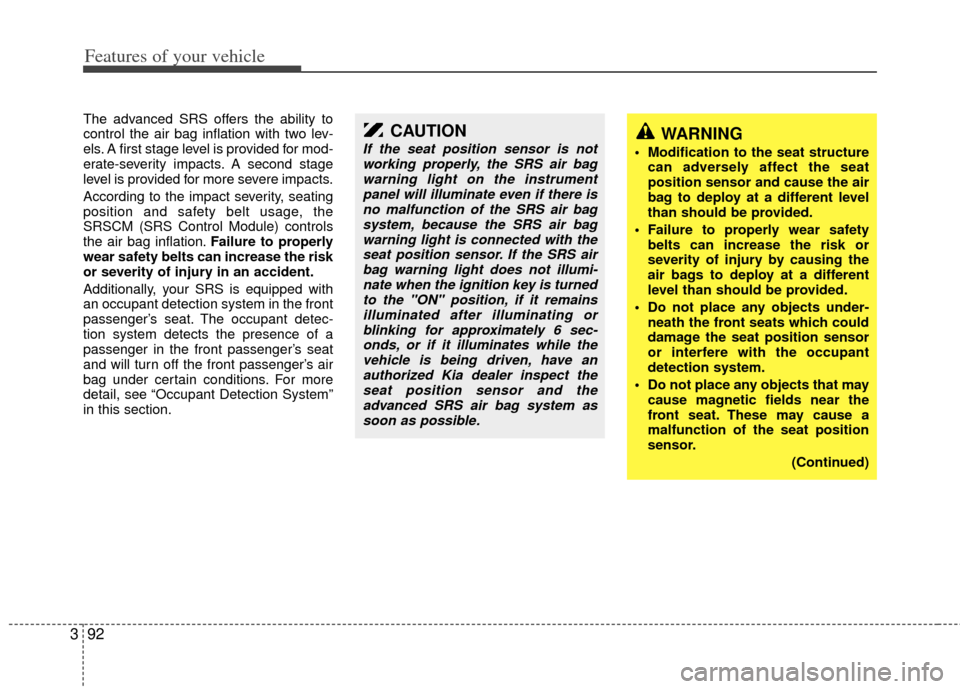
Features of your vehicle
92
3
The advanced SRS offers the ability to
control the air bag inflation with two lev-
els. A first stage level is provided for mod-
erate-severity impacts. A second stage
level is provided for more severe impacts.
According to the impact severity, seating
position and safety belt usage, the
SRSCM (SRS Control Module) controls
the air bag inflation. Failure to properly
wear safety belts can increase the risk
or severity of injury in an accident.
Additionally, your SRS is equipped with
an occupant detection system in the front
passenger’s seat. The occupant detec-
tion system detects the presence of a
passenger in the front passenger’s seat
and will turn off the front passenger’s air
bag under certain conditions. For more
detail, see “Occupant Detection System”
in this section.CAUTION
If the seat position sensor is not working properly, the SRS air bagwarning light on the instrumentpanel will illuminate even if there isno malfunction of the SRS air bag system, because the SRS air bagwarning light is connected with theseat position sensor. If the SRS airbag warning light does not illumi-nate when the ignition key is turnedto the "ON" position, if it remainsilluminated after illuminating orblinking for approximately 6 sec-onds, or if it illuminates while the vehicle is being driven, have anauthorized Kia dealer inspect theseat position sensor and theadvanced SRS air bag system assoon as possible.WARNING
Modification to the seat structure can adversely affect the seat
position sensor and cause the air
bag to deploy at a different level
than should be provided.
Failure to properly wear safety belts can increase the risk or
severity of injury by causing the
air bags to deploy at a different
level than should be provided.
Do not place any objects under- neath the front seats which could
damage the seat position sensor
or interfere with the occupant
detection system.
Do not place any objects that may cause magnetic fields near the
front seat. These may cause a
malfunction of the seat position
sensor.
(Continued)
Page 103 of 382
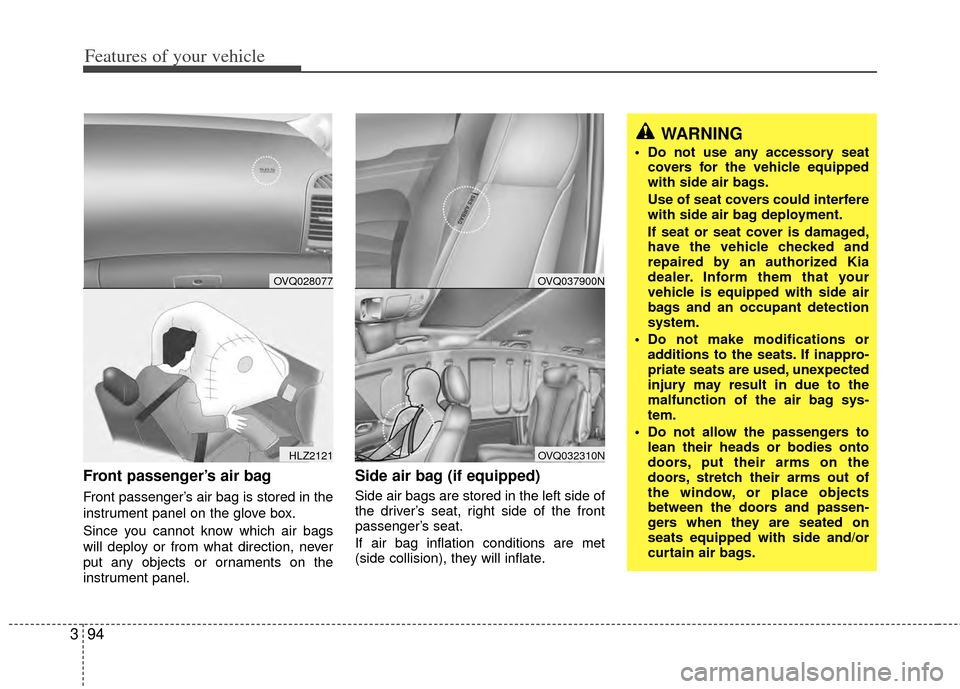
Features of your vehicle
94
3
Front passenger’s air bag
Front passenger’s air bag is stored in the
instrument panel on the glove box.
Since you cannot know which air bags
will deploy or from what direction, never
put any objects or ornaments on the
instrument panel.
Side air bag (if equipped)
Side air bags are stored in the left side of
the driver’s seat, right side of the front
passenger’s seat.
If air bag inflation conditions are met
(side collision), they will inflate.
OVQ028077
HLZ2121
WARNING
Do not use any accessory seat
covers for the vehicle equipped
with side air bags.
Use of seat covers could interfere
with side air bag deployment.
If seat or seat cover is damaged,
have the vehicle checked and
repaired by an authorized Kia
dealer. Inform them that your
vehicle is equipped with side air
bags and an occupant detection
system.
Do not make modifications or additions to the seats. If inappro-
priate seats are used, unexpected
injury may result in due to the
malfunction of the air bag sys-
tem.
Do not allow the passengers to lean their heads or bodies onto
doors, put their arms on the
doors, stretch their arms out of
the window, or place objects
between the doors and passen-
gers when they are seated on
seats equipped with side and/or
curtain air bags.
OVQ037900N
OVQ032310N
Page 105 of 382
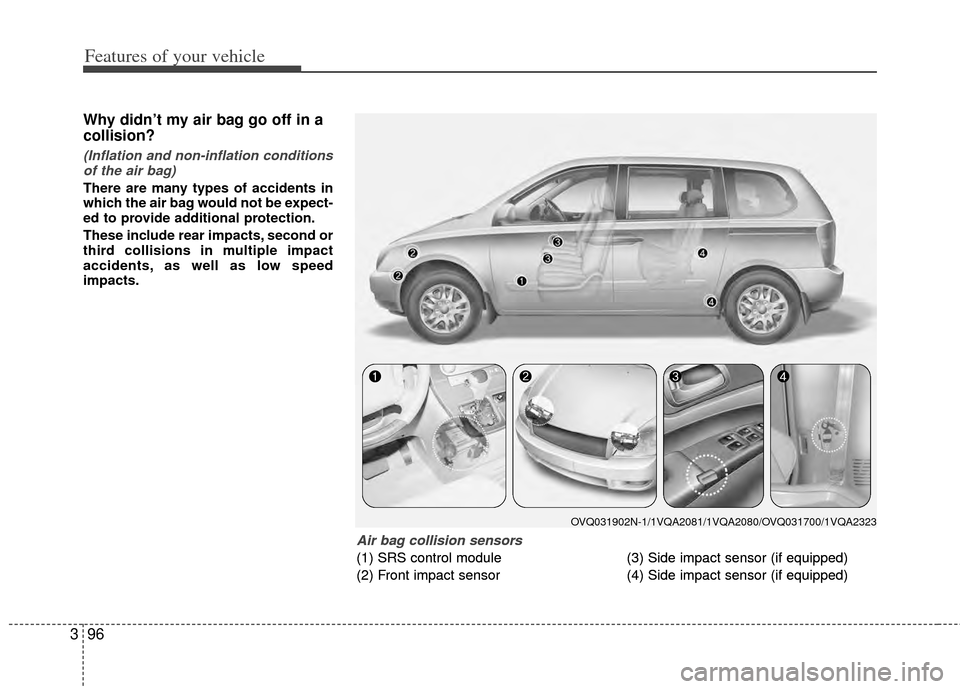
Features of your vehicle
96
3
Why didn’t my air bag go off in a
collision?
(Inflation and non-inflation conditions
of the air bag)
There are many types of accidents in
which the air bag would not be expect-
ed to provide additional protection.
These include rear impacts, second or
third collisions in multiple impact
accidents, as well as low speed
impacts.
Air bag collision sensors
(1) SRS control module
(2) Front impact sensor (3) Side impact sensor (if equipped)
(4) Side impact sensor (if equipped)
Air bag collision sensors
(1) SRS control module
(2) Front impact sensor(3) Side impact sensor (if equipped)
(4) Side impact sensor (if equipped)
OVQ031902N-1/1VQA2081/1VQA2080/OVQ031700/1VQA2323
Page 106 of 382
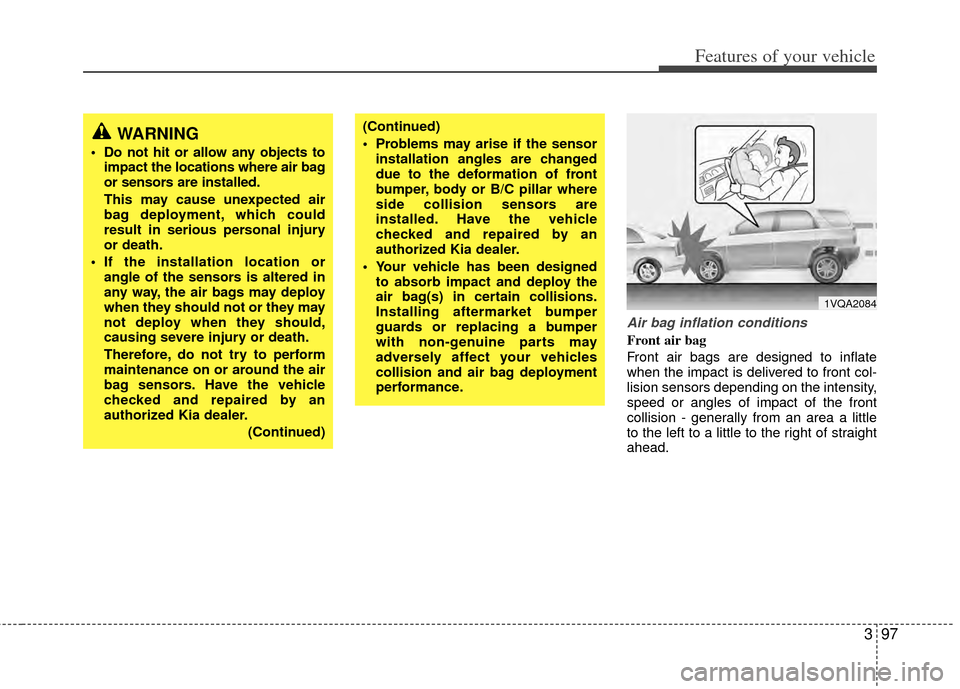
397
Features of your vehicle
Air bag inflation conditions
Front air bag
Front air bags are designed to inflate
when the impact is delivered to front col-
lision sensors depending on the intensity,
speed or angles of impact of the front
collision - generally from an area a little
to the left to a little to the right of straight
ahead.
1VQA2084
WARNING
Do not hit or allow any objects toimpact the locations where air bag
or sensors are installed.
This may cause unexpected air
bag deployment, which could
result in serious personal injury
or death.
If the installation location or angle of the sensors is altered in
any way, the air bags may deploy
when they should not or they may
not deploy when they should,
causing severe injury or death.
Therefore, do not try to perform
maintenance on or around the air
bag sensors. Have the vehicle
checked and repaired by an
authorized Kia dealer.
(Continued)
(Continued)
Problems may arise if the sensorinstallation angles are changed
due to the deformation of front
bumper, body or B/C pillar where
side collision sensors are
installed. Have the vehicle
checked and repaired by an
authorized Kia dealer.
Your vehicle has been designed to absorb impact and deploy the
air bag(s) in certain collisions.
Installing aftermarket bumper
guards or replacing a bumper
with non-genuine parts may
adversely affect your vehicles
collision and air bag deployment
performance.
Page 107 of 382
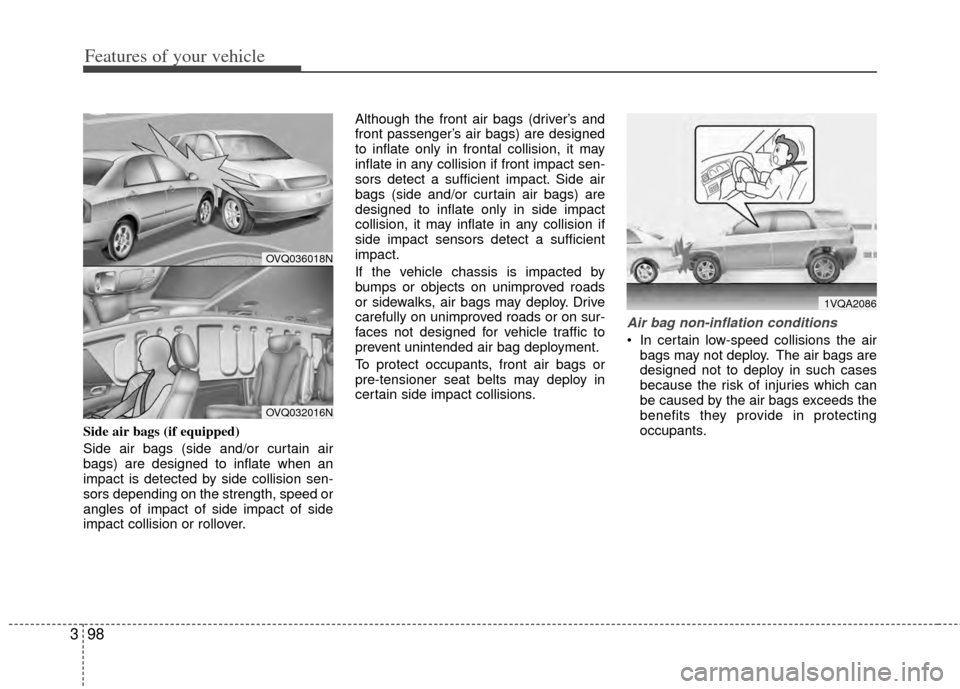
Features of your vehicle
98
3
Side air bags (if equipped)
Side air bags (side and/or curtain air
bags) are designed to inflate when an
impact is detected by side collision sen-
sors depending on the strength, speed or
angles of impact of side impact of side
impact collision or rollover. Although the front air bags (driver’s and
front passenger’s air bags) are designed
to inflate only in frontal collision, it may
inflate in any collision if front impact sen-
sors detect a sufficient impact. Side air
bags (side and/or curtain air bags) are
designed to inflate only in side impact
collision, it may inflate in any collision if
side impact sensors detect a sufficient
impact.
If the vehicle chassis is impacted by
bumps or objects on unimproved roads
or sidewalks, air bags may deploy. Drive
carefully on unimproved roads or on sur-
faces not designed for vehicle traffic to
prevent unintended air bag deployment.
To protect occupants, front air bags or
pre-tensioner seat belts may deploy in
certain side impact collisions.
Air bag non-inflation conditions
In certain low-speed collisions the air
bags may not deploy. The air bags are
designed not to deploy in such cases
because the risk of injuries which can
be caused by the air bags exceeds the
benefits they provide in protecting
occupants.
OVQ036018N
OVQ032016N
1VQA2086
Page 119 of 382
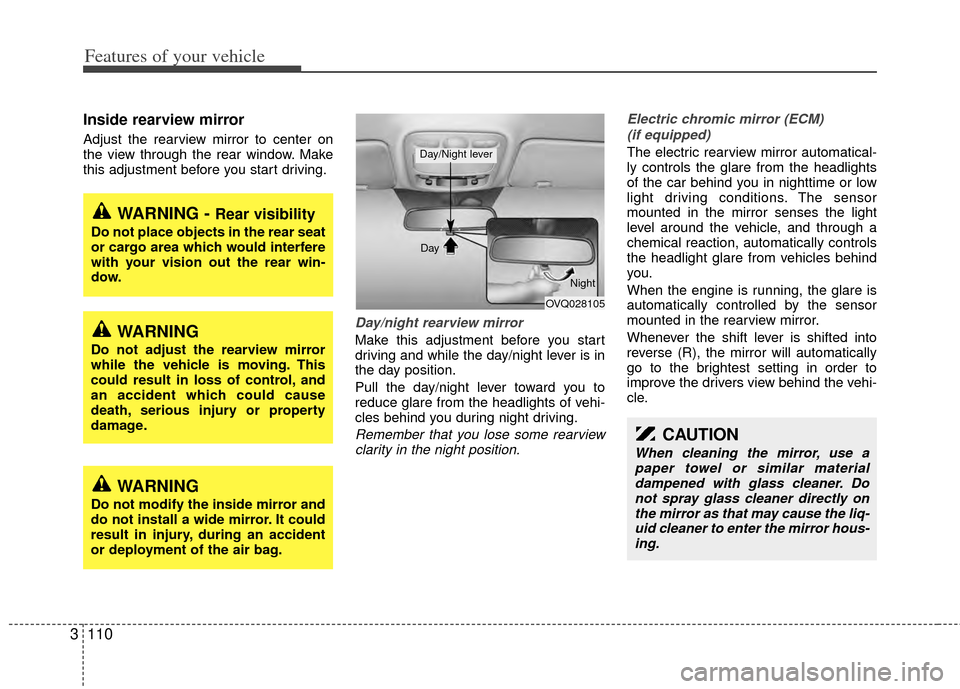
Features of your vehicle
110
3
Inside rearview mirror
Adjust the rearview mirror to center on
the view through the rear window. Make
this adjustment before you start driving.
Day/night rearview mirror
Make this adjustment before you start
driving and while the day/night lever is in
the day position.
Pull the day/night lever toward you to
reduce glare from the headlights of vehi-
cles behind you during night driving.
Remember that you lose some rearview
clarity in the night position. Electric chromic mirror (ECM)
(if equipped)
The electric rearview mirror automatical-
ly controls the glare from the headlights
of the car behind you in nighttime or low
light driving conditions. The sensor
mounted in the mirror senses the light
level around the vehicle, and through a
chemical reaction, automatically controls
the headlight glare from vehicles behind
you.
When the engine is running, the glare is
automatically controlled by the sensor
mounted in the rearview mirror.
Whenever the shift lever is shifted into
reverse (R), the mirror will automatically
go to the brightest setting in order to
improve the drivers view behind the vehi-
cle.
WARNING - Rear visibility
Do not place objects in the rear seat
or cargo area which would interfere
with your vision out the rear win-
dow.
CAUTION
When cleaning the mirror, use apaper towel or similar materialdampened with glass cleaner. Do not spray glass cleaner directly onthe mirror as that may cause the liq- uid cleaner to enter the mirror hous-ing.
OVQ028105
Day
Night
Day/Night lever
WARNING
Do not adjust the rearview mirror
while the vehicle is moving. This
could result in loss of control, and
an accident which could cause
death, serious injury or property
damage.
WARNING
Do not modify the inside mirror and
do not install a wide mirror. It could
result in injury, during an accident
or deployment of the air bag.